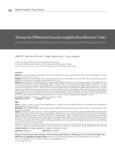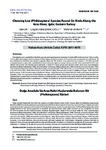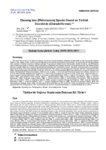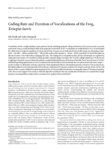|
|
Creator | Title | Description | Subject | Date |
| 76 |
 |
Bastiani, Michael | Cell-cell interactions during the migration of an identified commissural growth cone in the embryonic grasshopper | One of the fascicles of the posterior commissure of the embryonic grasshopper is pioneered by an individually identifiable neuron named Q1. Q1 initially grows along a longitudinal pathway established by another pioneer neuron, MPl, and then crosses to the midline, where it meets and fasciculates wi... | Commissure; Pathfinding; Filopodia | 1993 |
| 77 |
 |
Gesteland, Raymond F. | Cell-free synthesis of herpes simplex virus proteins | Polyribosomes isolated from herpes simplex virus type I (HSV-1)-infected cells have been used to program a eucaryotic cell-free translation system. At least 10 HSV-specific polypeptides, with apparent molecular weights of 25,000 to 160,000, are synthesized by wild-type HSV-infected polyribosomes. Po... | Viral Proteins; Herpes Simplex; Peptide Biosynthesis; Thymidine Kinase | 1977 |
| 78 |
 |
Bastiani, Michael | Central projections of the stretch receptor neurons of crayfish: segmental gradients of synaptic probability and strength | The 20 stretch receptor neurons (SRs) of the crayfish abdomen send axons into the CNS that then project both to the brain and to the last abdominal ganglion, G6 (Bastiani and Mulloney, 1988). In G6, we recorded intracellularly from different kinds of neurons postsynaptic to SR axons. | Axons; Synapses; SR | 1988 |
| 79 |
 |
Bastiani, Michael | Central projections of the stretch receptor neurons of crayfish: structure, variation, and postembryonic growth | Each stretch receptor neuron (SR) of the crayfish abdomen projects from its peripherally located soma an axon that enters the CNS through the second nerve (N2) of its segmental ganglion. CoZ+ backfills of N2 revealed that this axon bifurcates, sending one branch to the brain and the other to the te... | Abdomen; Axon; Ganglion | 1988 |
| 80 |
 |
Gesteland, Raymond F. | Characterization of lysozyme messenger and lysozyme synthesized in vitro | In vitro systems for protein systhesis have been in wide use for about 10 years. In most of the early work protein synthesis was measured by following the incorporation of radioactive amino acids into acid precipitable material. This test cannot distinguish between the synthesis of complete, activ... | Lysozyme Messenger; Lysozyme Synthesized; Protein Synthesis | 1969 |
| 81 |
 |
Beckerle, Mary C. | Characterization of the interaction between zyxin and members of the Ena/Vasodilator-stimulated Phosphoprotein family of proteins | Zyxin contains a proline-rich N-terminal domain that is similar to the C-terminal domain in the ActA protein of the bacteria, Listeria monocytogenes. We screened the entire amino acid sequence of human zyxin for Menainteracting peptides and found that, as with ActA, proline-rich sequences were the s... | Zyxin; Actin; Listeria monocytogenes; Proline-rich repeats; Cell spreading | 2000 |
| 82 |
 |
Capecchi, Mario R. | Characterization of three proteins involved in polypeptide chain termination. | At each stage of elongation, the growing polypeptide chain is bound to the ribosome-messenger RNA complex through the transfer RNA of the most recently incorporated amino acid residue. When the chain is complete, the last polypeptide-transfer RNA (tuna) ester linkage is cleaved, releasing the chain ... | Anti-Bacterial Agents; Phenylalanine; Stimulation, Chemical | 1969 |
| 83 |
 |
Coley, Phyllis D. | Chemical and bioactive natural products from microthyriaceae sp., an endophytic fungus from a tropical grass | In screening for natural products with antiparasitic activity, an endophytic fungus, strain F2611, isolated from above-ground tissue of the tropical grass Paspalum conjugatum (Poaceae) in Panama, was chosen for bioactive principle elucidation. Cultivation on malt extract agar (MEA) followed by bioas... | | 2014-01-01 |
| 84 |
 |
Blair, David F. | Chemical and spectroscopic evidence for the formation of a ferryl Fea3 intermediate during turnover of cytochrome c oxidase | When partially reduced cytochrome c oxidase samples are reoxidized with dioxygen, an EPR-silent dioxygen intermediate, which is at the three-electron level of dioxygen reduction, is trapped at the dioxygen reduction site. The intermediate has novel spectral features at 580 and 537 nm. Combined op... | Cytochrome c oxidase; EPR; Fea3 intermediate; Reduction | 1986 |
| 85 |
 |
Sekercioglu, Cagan | Chewing lice (phthiraptera) found on songbirds (Passeriformes) in Turkey | Objective: This study was performed to detect chewing lice species found on the songbirds at Lake Kuyucuk bird ringing station in the Kars province located in eastern Turkey. Methods: Chewing lice were collected from songbirds captured between September and October 2009. Fifty-one birds belonging t... | | 2011-01-01 |
| 86 |
 |
Sekercioglu, Cagan | Chewing lice (phthiraptera) species found on birds along the Aras River, lgdir, Eastern Turkey | Chewing lice were sampled from the birds captured and ringed between September-October 2009 at the Aras River (Yukarı Çıyrıklı, Tuzluca, Iğdır) bird ringing station in eastern Turkey. Eighty-one bird specimens of 23 species were examined for lice infestation. All lice collected from the birds... | | 2011-01-01 |
| 87 |
 |
Sekercioglu, Cagan | Chewing lice (Phthiraptera) species found on Turkish shorebirds (Charadriiformes) | Approximately 4.500 species of lice have been so far described, with about 4.000 species seen on birds and with 3.000 species in the suborder Ischnocera 1. There are 465 bird species so far recorded in Turkey and the actual total is likely to exceed 500 species. However, the chewing lice fauna of th... | | 2010-01-01 |
| 88 |
 |
Bohs, Lynn A. | Chloroplast DNA phylogeny of Solanum sect on Las ocarpa | Solanum section Lasiocarpa includes about a dozen species with a center of diversity in the NewWorld tropics. Solanum lasiocarpum and S. repandum (sometimes considered to be conspecific as S. ferox) have an Old World distribution in Asia and the Pacific Islands. Several species in this section produ... | Solanum; trn; Lasiocarpa | 2004 |
| 89 |
 |
Capecchi, Mario R. | Choose your target. | The technology of modifying endogenous genes has recently been extended from mice to Drosophila and sheep. Concurrently, genomic sequencing is uncovering thousands of previously uncharacterized genes. Armed with today's technologies, what are our best options for delineating the functions of these n... | Animals; Mice; Sheep | 2000-09-13 |
| 90 |
 |
Capecchi, Mario R. | Cleft palate in mice with a targeted mutation in the gamma-aminobutyric acid-producing enzyme glutamic acid decarboxylase 67. | The functions of neurotransmitters in fetal development are poorly understood. Genetic observations have suggested a role for the inhibitory amino acid neurotransmitter gamma-aminobutyric acid (GABA) in the normal development of the mouse palate. Mice homozygous for mutations in the beta-3 GABAA rec... | Animals, Newborn; Crosses, Genetic | 1997-10-14 |
| 91 |
 |
Yamaguchi, Ayako | Coding rate and duration of vocalizations of the frog , Xenopus laevis | Vocalizations involve complex rhythmic motor patterns, but the underlying temporal coding mechanisms in the nervous system are poorly understood. Using a recently developed whole-brain preparation from which "fictive" vocalizations are readily elicited in vitro, we investigated the cellular basis of... | | 2012-08-29 |
| 92 |
 |
Clayton, Dale H. | Coevolutionary history of ecological replicates: comparing phylogenies of wing and body lice to Columbiform hosts | Phylogenies depict the history of speciation for groups of organisms. Comparing the phylogenies of interacting groups can reveal instances of tandem speciation, or "cospeciation" (Brooks and McLennan, 1991; Hoberg et al., 1997; Paterson and Gray, 1997). Understanding the conditions under which cosp... | Feather lice; Wing lice; Body lice; Cospeciation | 2003 |
| 93 |
 |
Coley, Phyllis D. | Coibanoles, a new class of meroterpeniods produced by pycnoporus sanguineus | Three new terpenoids of mixed biosynthetic origin were isolated from the culture filtrate of the endophytic fungus Pycnoporus sanguineus. Their structures were determined by extensive spectroscopic analyses. We have named these tricyclic and tetracyclic metabolites ?coibanoles A?C? in reference to... | | 2012 |
| 94 |
 |
Coley, Phyllis D.; Kursar, Thomas A. | Colonization of tropical rain forest leaves by epiphylls: effects of site and host plant leaf lifetime | In humid tropical regions, leaves are frequently colonized by epiphylls (Richards 1954, Pocs 1978, 1982). Lichens and liverworts usually dominate, although mosses, algae, and cyanobacteria can also occur (Winkler 1971, Smith 1982). The interactions between epiphylls and host leaves have not been wel... | Tropical forest; Epiphylls; Panama; Hybanthus prunifolius; Light interception | 1993 |
| 95 |
 |
Olivera, Baldomero M. | Combined proteomic and transcriptomic interrogation of the venom gland of conus geographus uncovers novel components and functional compartmentalization | Cone snails are highly successful marine predators that use complex venoms to capture prey. At any given time, hundreds of toxins (conotoxins) are synthesized in the secretory epithelial cells of the venom gland, a long and convoluted organ that can measure 4 times the length of the snail's body. In... | | 2014-01-01 |
| 96 |
 |
Clayton, Dale H. | Common grackle anting with lime fruit and its effect on ectoparasites | Anting is stereotyped behavior in which birds ex- pose themselves to fluid-secreting ants or other pun- gent substances. During "active" anting a bird crush- es an ant in the bill and rubs it frenetically through its plumage (Rothschild and Clay 1952). During "passive" anting a bird entices ants to ... | Quiscalus quiscala; Columbicola columbae; Anting; Ectoparasites | 1993 |
| 97 |
 |
Clayton, Dale H. | Comparative effects of mites and lice on the reproductive success of rock doves (Columba livia) | We report experimental data comparing the effects of Mesostigmatid mites and Ischnoceran lice on the reproductive performance of a single group of captive rock doves (Columba livid). Several components of host reproductive success were compared for the two groups, including number of eggs laid, hatc... | Ectoparasites; Reproduction; Rock doves; Columba livia; Ischnocera; Mites; Lice | 1995 |
| 98 |
 |
Davidson, Diane W. | Comparative structure of harvester ant communities in arid Australia and North America | In the Australian arid zone, the species richness of ants is greater and that of mammalian granivores is less than in North American deserts. This study aimed to determine if the structure of harvester ant communities differs from that seen in North American deserts, focussing on differences relate... | Species; Rodents; Diversity | 1988 |
| 99 |
 |
Clayton, Dale H.; Bush, Sarah Elizabeth | Comparative transmission dynamics of competing parasite species | Competition-colonization trade-off models explain the coexistence of competing species in terms of a trade-off between competitive ability and the ability to colonize competitor-free patches of habitat. A simple prediction of these models is that inferior competitors will be superior dispersers. Thi... | Bird lice; Campanulotes compar; Coexistence; Colonization; Columba livia; Columbicola columbae; Competition; Dispersal; Parasite; Phoresis; Specificity; Pseudolynchia canariensis; Phthiraptera | 2008 |
| 100 |
 |
Hultine, Kevin | Comparison of methods to estimate Ephemeral Channel Recharge, Walnut Gulch, San Pedro River Basin, Arizona | Ephemeral channel transmission loss represents an important groundwater surface water exchange in arid and semiarid regions and is potentially a significant source of recharge at the basin scale. Copyright [year] American Geophysical Union. Reproduced by permission of American Geophysical Union. ... | Transport; Transmission; Balance | 2004 |

























